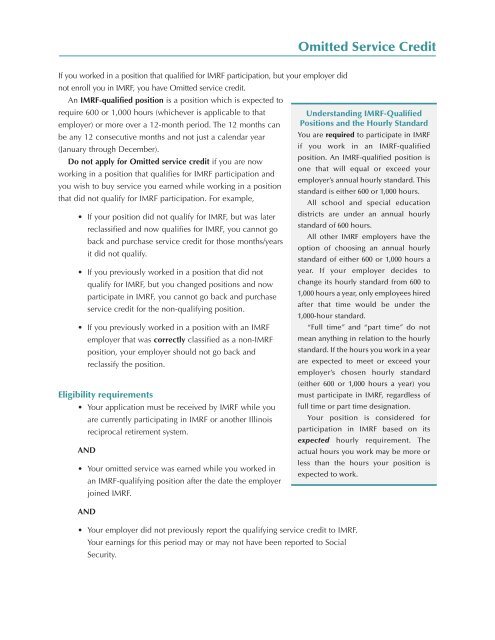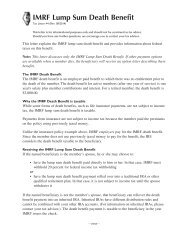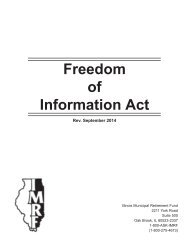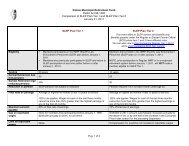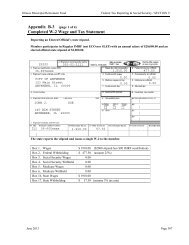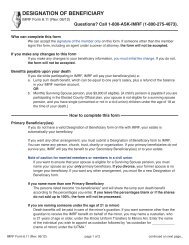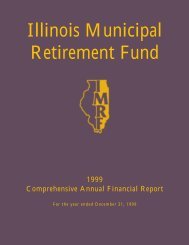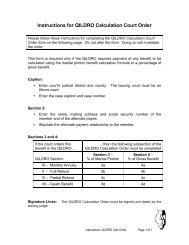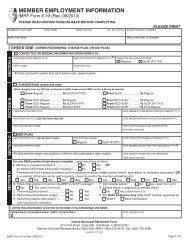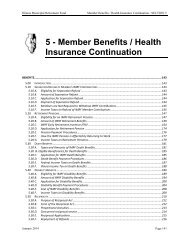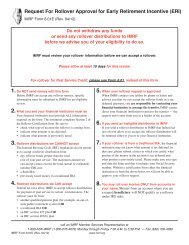Omitted Service Credit - Purchasing Past Service - IMRF
Omitted Service Credit - Purchasing Past Service - IMRF
Omitted Service Credit - Purchasing Past Service - IMRF
You also want an ePaper? Increase the reach of your titles
YUMPU automatically turns print PDFs into web optimized ePapers that Google loves.
<strong>Omitted</strong> <strong>Service</strong> <strong>Credit</strong>If you worked in a position that qualified for <strong>IMRF</strong> participation, but your employer didnot enroll you in <strong>IMRF</strong>, you have <strong>Omitted</strong> service credit.An <strong>IMRF</strong>-qualified position is a position which is expected torequire 600 or 1,000 hours (whichever is applicable to thatUnderstanding <strong>IMRF</strong>-Qualifiedemployer) or more over a 12-month period. The 12 months can Positions and the Hourly Standardbe any 12 consecutive months and not just a calendar year You are required to participate in <strong>IMRF</strong>(January through December).if you work in an <strong>IMRF</strong>-qualifiedposition. An <strong>IMRF</strong>-qualified position isDo not apply for <strong>Omitted</strong> service credit if you are nowone that will equal or exceed yourworking in a position that qualifies for <strong>IMRF</strong> participation andemployer’s annual hourly standard. Thisyou wish to buy service you earned while working in a positionstandard is either 600 or 1,000 hours.that did not qualify for <strong>IMRF</strong> participation. For example,All school and special education• If your position did not qualify for <strong>IMRF</strong>, but was later districts are under an annual hourlystandard of 600 hours.reclassified and now qualifies for <strong>IMRF</strong>, you cannot goAll other <strong>IMRF</strong> employers have theback and purchase service credit for those months/yearsoption of choosing an annual hourlyit did not qualify.standard of either 600 or 1,000 hours a• If you previously worked in a position that did not year. If your employer decides toqualify for <strong>IMRF</strong>, but you changed positions and now change its hourly standard from 600 to1,000 hours a year, only employees hiredparticipate in <strong>IMRF</strong>, you cannot go back and purchaseafter that time would be under theservice credit for the non-qualifying position.1,000-hour standard.• If you previously worked in a position with an <strong>IMRF</strong>“Full time” and “part time” do notemployer that was correctly classified as a non-<strong>IMRF</strong> mean anything in relation to the hourlyposition, your employer should not go back andstandard. If the hours you work in a yearreclassify the position.are expected to meet or exceed youremployer’s chosen hourly standard(either 600 or 1,000 hours a year) youEligibility requirementsmust participate in <strong>IMRF</strong>, regardless of• Your application must be received by <strong>IMRF</strong> while you full time or part time designation.are currently participating in <strong>IMRF</strong> or another Illinois Your position is considered forreciprocal retirement system.participation in <strong>IMRF</strong> based on itsexpected hourly requirement. TheANDactual hours you work may be more orless than the hours your position is• Your omitted service was earned while you worked inexpected to work.an <strong>IMRF</strong>-qualifying position after the date the employerjoined <strong>IMRF</strong>.AND• Your employer did not previously report the qualifying service credit to <strong>IMRF</strong>.Your earnings for this period may or may not have been reported to SocialSecurity.
<strong>Omitted</strong> <strong>Service</strong> <strong>Credit</strong>Special considerations for seasonal employeesSome members who work in seasonal positions have the choice of being paid over12 months or being paid only during the months they work. For example, someschool districts allow an employee to choose to be paid over 12 months (includingsummer months) or over the nine months school is in session.If you worked in a seasonal position and the only time omitted fromyour <strong>IMRF</strong> service credit were your “off months,” it is not considered<strong>Omitted</strong> service credit. Contact your employer directly so it may filean adjustment for those months.If you worked in a seasonal position and wish to purchase <strong>Omitted</strong> service creditfor months you worked as well as for months you did not receive earnings (your “offseason” months), you may receive service credit for those “off season” monthswithout earnings if:• You worked the required number of months for your seasonal position duringthe year.AND• You had earnings reported for all non-seasonal months during a 12-monthperiod.AND• You continued to be employed by your employer during your seasonal leaveperiod (“off season” months) and you returned to work (received earnings) afterthe leave period.If you did not return to work (receive earnings) after the seasonal leaveperiod, your employer must explain why and <strong>IMRF</strong> will determine whetherthe service should be granted.
<strong>Omitted</strong> <strong>Service</strong> <strong>Credit</strong>Special considerations for elected officials or city hospital employeesElected officials and city hospital workers have the option to participate in <strong>IMRF</strong> iftheir positions qualify. For this reason, if you are an elected official or city hospitalemployee and wish to purchase omitted service credit, you may do so only under thefollowing circumstance:• The omitted service must have been earned after you signed <strong>IMRF</strong> Form 6.21,“Election to Participate.” If the omitted service was earned before you signedForm 6.21, it is considered Retroactive service credit.What you must doYou must complete and sign the top half of <strong>IMRF</strong> Form 6.05, “<strong>Omitted</strong> <strong>Service</strong> <strong>Credit</strong>Verification,” and then give the form to the employer that did not enroll you in <strong>IMRF</strong>for wage and service certification.What your employer must doThe employer’s Authorized Agent must complete the bottom section of <strong>IMRF</strong> Form6.05, “<strong>Omitted</strong> <strong>Service</strong> <strong>Credit</strong> Verification,” and submit the form to <strong>IMRF</strong>.The employer must submit an omitted service applicationif it finds that you were omitted from <strong>IMRF</strong> coverage in error.The Illinois Pension Code does not allow employers to not enroll a new employee in<strong>IMRF</strong> because of a probationary work period. Enrollment in <strong>IMRF</strong> is required startingwith the date you begin your <strong>IMRF</strong>-qualified position, regardless of your employer’spolicies.If your employer did not enroll you in <strong>IMRF</strong> immediately because it declared yourposition probationary, the service you earned before you were enrolled in <strong>IMRF</strong>would be considered <strong>Omitted</strong> service credit and you could be eligible to purchasethat time.All omitted service applications must be signed by the Authorized Agent of theemployer that omitted the coverage period. The employer’s cost for the serviceshould not be a factor in determining eligibility for <strong>Omitted</strong> service.
<strong>Omitted</strong> <strong>Service</strong> <strong>Credit</strong>The amount of <strong>Omitted</strong> service you may purchase is limited only by the period oftime your position qualified for <strong>IMRF</strong> participation but your employer did not reportyou.Example:You worked for three years in a qualifying position but your employerreported only six months You can purchase up to two years and sixmonths of service under <strong>Omitted</strong> service credit.<strong>Purchasing</strong> any amount of service is optional to you. You may purchase all, none,or a portion of your <strong>Omitted</strong> service credit; however, you cannot choose the specificmonths of service.You purchase <strong>Omitted</strong> service beginning with your most recent month of service.For example, if you have <strong>Omitted</strong> service for the months of October, November, andDecember 2000 and January and February 2001, you would purchase February 2001,then January 2001, then December 2000, etc.How costs are calculatedYour cost is calculated using your actual earnings during your omitted period and themember contribution rate(s) in effect during that time (the current Regular <strong>IMRF</strong> Plancontribution rate of 4.5% has been in effect since January 1, 1973).Example: Your employer omitted six months of service, from January 1995through June 1995, and it is now June 2008. During 1995, you were paid $1,000 amonth and you would have participated in the Regular <strong>IMRF</strong> plan.Total <strong>Omitted</strong> Salary: $1,000 x 6 months = $6,000Total <strong>Omitted</strong> Contributions: $6,000 x 4.5% = $270Employer contribution costs are paid through future employer contributionrates.


